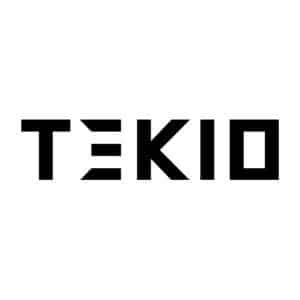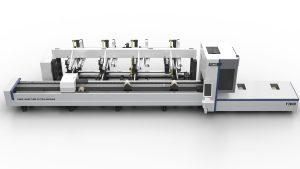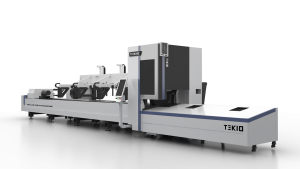Traditional cutting process versus laser cutting process
Due to the current rapid development and production needs of the laser processing industry, the demand for cutting metal materials of different materials, thicknesses and shapes has increased greatly. In order to cope with the increasingly severe market competition, laser cutting machine has become the best choice for large-scale metal cutting industry
First, let’s first understand the advantages and disadvantages of the traditional cutting process; traditional cutting process is mainly done by CNC shears, punching machines, flame cutting, plasma cutting, high-pressure water cutting and other equipment
(CNC) shearing machines
CNC shears use sharp blades to cut sheet metal. It is a machine that uses one blade to cut the sheet in a reciprocating linear motion relative to another blade belongs to a group of forging machines.
Advantages: They are ideal for high volume production and can be easily programmed for repetitive work. They are also relatively fast and can handle a range of different sheet metal thicknesses.
Cons: Shear beds are more versatile and are mainly used in sheet metal processing where only straight cuts are required. They are not flexible and do not support cutting multiple patterns and cutting thicker or harder materials.
(CNC/Turret) Punching Machine
Punching machines use a punching tool and a die to cut holes and other shapes in sheet metal. It is mainly suitable for cutting simple shapes such as square and round holes.
Advantages: Punching machines offer increased flexibility in the processing of curves. Punching machines are fast and efficient and can be easily programmed to perform repetitive work. They are also capable of creating complex shapes and patterns.
Cons: Punch presses are not suitable for cutting thicker or harder materials (below 2mm). They are also highly dependent on tooling and have long tooling development cycles, increased production costs, and low flexibility. And for thick steel plate processing surface is not smooth, easy to produce collapse groove, and conventional forming will cause some damage to the outer surface of the material, processing noise
Flame cutting
Flame cutting is a thermal cutting process that uses a high temperature flame to cut metal. The process involves heating the metal to its ignition temperature and then blowing a stream of oxygen into the metal, creating a chemical reaction that cuts the metal.
Advantages: Flame cutting is relatively fast and can handle thick materials. It is also a relatively low-cost method of cutting metal.
Disadvantages: Flame cutting is not suitable for cutting thinner materials or materials that are highly sensitive to heat, and the material will be more thermally deformed, creating a rougher edge that requires secondary processing.
Plasma cutting
Plasma cutting is a process that uses a high-temperature plasma arc to cut metal. The process involves passing an electric current through a gas, which ionizes the gas and creates a plasma arc to cut the metal.
Advantages:Plasma cutting is fast, has a smooth cutting surface, and can handle a range of different thicknesses of material. It is also capable of cutting a variety of non-ferrous metals, including stainless steel and aluminum.
Disadvantages: Plasma cutting may not be suitable for cutting thicker materials or materials that are highly sensitive to heat. It can produce a rough edge, along with a large amount of metal powder and blinding glare, which can have some impact on production safety.
High-pressure water cutting
Principle: High-pressure water cutting is a process that uses a high-pressure water jet to cut a variety of materials, including metals. The process involves pressurizing water to an extremely high level and then directing the water jets onto the material to be cut.
Advantages: High-pressure waterjet cutting is a precise cutting method that can handle a range of different materials.
Disadvantages: “Waterjet” encounters high hardness or thick plate cutting slow speed, messy operating environment, high consumables.
Laser Cutting
Although conventional cutting processes are well established and offer cost advantages and certain capabilities, their drawbacks quickly become apparent in the production process. Rough metal processing and the need for extensive tooling support lead to higher production costs and a particular waste of time and labor. In addition, conventional cutting processes can lead to inconsistent product quality and insufficient production speed, which can lead to order backlogs. In response to these production problems, intelligent and efficient fiber laser cutting machines were developed to keep up with the demands of modern manufacturing.
The principle of laser cutting is based on the use of a high-powered laser beam to cut a variety of materials, including metal, wood, plastic and more. The laser beam is focused and directed at the material to be cut, and it heats the material to its melting or vaporization point, creating a narrow cut with high precision.
The laser cutting process involves several components, including a laser source, focusing optics and a computer control system to guide and regulate the laser beam. The laser source produces a high-powered beam of light, usually using a carbon dioxide (CO2) gas laser or a fiber laser. Focusing optics, such as mirrors and lenses, focus the laser beam to a small, precise location on the material to be cut. A computer-controlled system, or CNC, directs the laser beam along a predetermined path to the desired cut.
In addition to high precision, laser cutting offers many advantages over traditional cutting methods. Laser cutting is a non-contact process, which means there is no physical contact between the cutting tool and the material being cut. This eliminates the risk of material contamination or damage and allows for greater accuracy and faster cutting speeds, while avoiding the step of secondary grinding and processing of the material. The computer-controlled professional cutting software can cut complex shapes and patterns, providing companies with significant savings in labor and time costs, achieving a high degree of automated processing and production, ensuring excellent cutting quality while increasing production efficiency. Laser cutting machine is suitable for both precision parts processing and large metal plate and tube processing, with other traditional cutting process unparalleled production advantages. This is an advantage that other traditional cutting methods cannot match.



